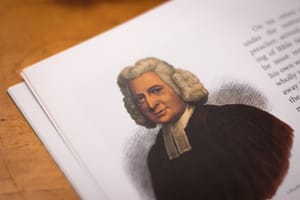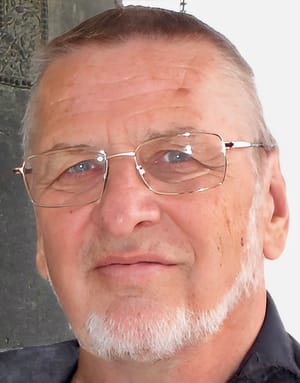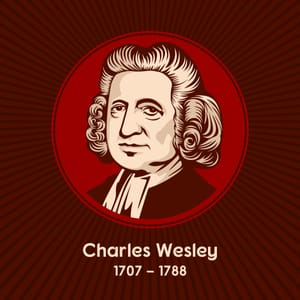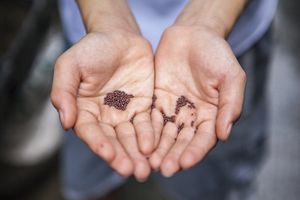Zachary Macaulay
– unsung hero of Abolition
Four-year-old Tom Macaulay was on his best behaviour. It was 1804 and his father Zachary was taking him to Strawberry Hill, a pretentious eighteenth-century house designed on Gothic lines by Horace Walpole. They were visiting Walpole’s great niece, Lady Waldegrave.
Tom was a precocious child. During the visit a servant happened to spill hot coffee over Tom’s legs. Lady Waldegrave fussed over the distressed child, and after a few minutes asked him how he felt. He looked up and replied, ‘Thank you, madam, the agony is abated’!
This anecdote is one of several told about Zachary’s famous son – Thomas Babington Macaulay, born in 1800 at Rothley Temple, near Loughborough. Thomas was later famous as the historian Lord Macaulay.
Slavery in Jamaica
Zachary was born into a Church of Scotland manse in 1768. Aged fourteen, he went to work in a merchant’s office in Glasgow. There, according to an autobiographical fragment (1797), he fell in with scoffing university students.
‘David Hume was now my oracle. To profane the sacred name of God, to prostitute his word to the purpose of exciting licentious merriment, to tease and perplex with questions and sarcasm, simple and well meaning people, and to shake the faith of such of my companions as were not favoured with so bright a light as myself, was my pastime.
‘I began to think excess of wine, so far from being a sin, to be a ground of glorying; and it became one of the objects of my ambition to be able to see all my companions under the table’.
In 1784 the young man went to Jamaica and became book-keeper on a sugar plantation. There he encountered slavery.
The lot of British slaves in the Caribbean, cultivating and harvesting sugar cane, was the worst in the New World. A typical regime meant working under a hot sun six days a week in twelve hour shifts. Days were often followed by four to six hour alternate night shifts in the mill or boiling house.
In the mill the cane’s juice was squeezed out between vertical rollers; in the boiling house the juice was boiled in vats. Many an exhausted slave lost fingers in the rollers or was scalded by hot syrup.
Discipline was brutal, since owners regarded slaves as chattels rather than people and were nervous of slave uprisings. Plantation owners were rich aristocrats, often living in English mansions while their plantations were run by managers who used brutal punishments. Many slaves survived less than three years, but there was an ever flowing supply from West Africa.
Changed life
The ‘middle passage’ across the Atlantic took one to three months depending on wind and weather. Slaves were crammed into ships, chained in pairs and often so tightly packed together that they were forced to lie amidst their own and other slaves’ excreta and vomit. Little wonder that the death toll was anything up to 45% before slaves were offloaded and auctioned at the other end.
Initially repelled, Zachary began to adapt to his surroundings and became ‘callous and indifferent’. He returned to Britain three years later, lured by a job offer from an uncle. He went to stay with his sister Jean at Rothley. She had married Thomas Babington, owner of Rothley Temple, in 1787.
This visit was to change Macaulay’s life, for Babington was a Christ-like young man of evangelical conviction. It can’t have been easy for Babington, since initially Macaulay manifested a boorish and self-opinionated manner. But Babington knew what Christ could do for his Scottish brother-in-law.
Zachary later wrote of Thomas Babington: ‘I never think of him but my thoughts are drawn to that Saviour with whom he first brought me acquainted’. He also said: ‘I can scarce ever think on my past life without adverting to those words of John Newton’s:
Thou didst once a wretch beholdIn rebellion blindly boldScorn thy grace, thy power defyThat poor rebel, Lord, was I.
The Clapham Sect
Zachary was introduced to Babington’s friends. William Wilberforce, Thomas Gisborne and Babington had been students together at St John’s College, Cambridge. Gisborne was an evangelical clergyman who married Babington’s sister.
This circle coalesced into another evangelical Anglican fraternity later known as the Clapham Sect, with many of its members residing in Clapham village, south-west of London.
From 1792-1815 the Sect promoted the gospel at home and abroad and worked for a reformation of morals. Its leading members included Wilberforce, Babington and Gisborne, Granville Sharp, James Stephen, Henry Thornton, Charles Grant, John Shore, John Venn and Hannah More – whose life intersected with Zachary Macaulay’s at several points.
Hannah More lived with her four sisters in the Mendips. She was a literary figure who had become an evangelical Christian yet retained friendship with the cultural elite, including Horace Walpole – hence the visit to Lady Waldegrave. All the sisters were remarkable Christian ladies, full of good works.
Practical Christianity
The Sect’s most defining work of ‘practical Christianity’ was its campaign for the abolition of the slave trade. Even before Macaulay appeared on the scene, Wilberforce, Gisborne and Babington were working hard on the issue.
Zachary was quickly ‘talent-spotted’ for a project dear to their heart. The Sect had determined upon creating a homeland for freed slaves in Sierra Leone. Macaulay seemed just the man for the task. It was an inspired choice. Humanly speaking, he deserves the credit for Sierra Leone’s survival in its most vulnerable stages.
By 1794, at the age of 26, he was Sierra Leone’s Governor. His energy was astonishing. Although dour, Macaulay was intelligent, tenacious and imperturbable – and deeply spiritual. Like a latter day Nehemiah, he ran the settlement single-handed, dealing with slave traders, disease, rebellious settlers and fractious missionaries.
He helped set the colony on its feet after a devastating attack by the French. While briefly their captive, his priorities emerged when he wrote: ‘We found, in casting up the accounts that we had lost very little by the change. We were free from pain; we felt neither cold, nor hunger, nor thirst; in short, we found our happiness does not consist in the number of things we possess, but in the mind being so indifferent to externals as neither to feel their weight when present, nor their want when absent’.
Marriage
When Zachary returned worn-out to England, it was entirely in character that he chose to travel via Jamaica in a slave ship to gather data about the slave trade! Back in England he recovered health and in August 1799 married Selina Mills. Herein lies a story which could easily have come from the pen of contemporary novelist Jane Austen!
Zachary was 27 years old, a leader of men known to have sacrificed much for the Africans. Selina Mills was 29 and a protégée of Hannah More. According to Viscountess Knutsford, she was shy, very pretty and of a sweet disposition. The More sisters detected a mutual attraction, but deemed it imprudent for Selina to become entangled with a young man heading for hazardous West Africa.
In fairness, Selina was not keen on Africa either. But the root of the opposition was a ‘jealous affection’ on the part of Miss Patty More towards Selina. The sisters did everything they could to keep the couple apart, but things came unexpectedly to a head.
Zachary, about to go abroad, revealed to Hannah More his feelings about Selina. Hannah, misleadingly, implied that Selina was indifferent. Dinner that final afternoon proved a difficult meal. Macaulay determined to keep his feelings to himself and not impose on Selina; while she had great difficulty concealing her distress.
Zachary bade the sisters a formal farewell, yet on his way down to the carriage accidentally saw Selina ‘in a room downstairs alone and weeping bitterly, having been carefully excluded from the leave-taking in the drawing-room by the strategy of the Miss Mores.
‘The sight of her distress swept away all barriers of prudence. He gave expression to feelings which he had hitherto repressed successfully; and in the surprise and excitement of the moment, she responded with a frankness and warmth which assured him of the regard which he had inspired in her breast’ (Knutsford).
Supplying statistics
Following the marriage, Selina Macaulay visited the Mores and friendly relations were resumed! To quote Anne Stott, ‘Everyone agreed to “forget” the whole business’. But it had been nearly ruinous for the More sisters to interfere; Christians should not seek to control the consciences of others.
It is a measure of Macaulay’s graciousness that he was a stalwart help to Hannah More in her old age. Although by 1827 he had serious, unexpected financial problems (through no fault of his own) he helped Hannah with several anxieties.
In 1802 Zachary and Selina moved to Clapham, where they raised their nine children. Zachary became secretary to the Sierra Leone Company, a position he held until 1808 when the colony was transferred to the British Crown.
He worked on against slavery and was a valuable witness for parliamentary inquiries, with his insights into West Indies plantations and West African slave trading. He also had a phenomenal memory. The columnist Rosemary Goring says, ‘Macaulay supplied the statistics and facts for every single speech made in the House of Commons and the House of Lords during the decade it took to see the abolition of slavery across the empire’.
Enforcing Abolition
The Act for the Abolition of the Slave Trade was passed in March 1807. Thereafter Macaulay played a major part in ensuring it was enforced. At Vienna in 1815 he was in regular contact with the Duke of Wellington and Lord Castlereagh as they tried to block French efforts to revive the slave trade. It was said that Zachary was the only Claphamite Wellington liked!
Macaulay became editor of the Anti-Slavery Reporter and attacked the cruelties of Britain’s West Indian plantations. He was subjected to caricatures and scurrilous attacks, especially in the periodical John Bull, but showed great patience and courage.
He had once written to Selina, ‘Let us then draw from the living fountain of waters those streams of consolation which are in the power of the faithful and fervent prayer’. He knew how to draw on that fountain.
Slavery was abolished in Britain’s possessions in 1833, three days before the death of William Wilberforce. Five years later, in 1838, Zachary Macaulay also passed into the immediate presence of the Saviour, having spent his final years in obscurity. Today both men are commemorated in Westminster Abbey, although the outstanding contribution of Macaulay is largely forgotten.
Zachary Macaulay was an Evangelical. He opposed slavery because he wanted to see England spared God’s judgements. He desired that Christ’s gospel should prosper at home and abroad. Ephesians 2:9 says, ‘we are God’s workmanship, created in Christ Jesus to do good works, which God prepared in advance for us to do’. It was ‘good works’ that characterised the Clapham Sect. Good works appropriate to the day are still the only compelling evidence of a personal, saving relationship with Jesus Christ.
Sources
Booth, Charles; Zachary Macaulay; Longmans
Dictionary of National Biography; Oxford University Press
Goring, Rosemary, ‘Freedom fighter’; The Herald Magazine (06/01/07)
Knutsford, Viscountess; Life and letters of Zachary Macaulay; Edward Arnold
Sheppard, Terry & Whyte, Iain; Rothley and the abolition of the slave trade; Rothley Historical Society
Stott, Anne; Hannah More – The first Victorian; Oxford University Press



















